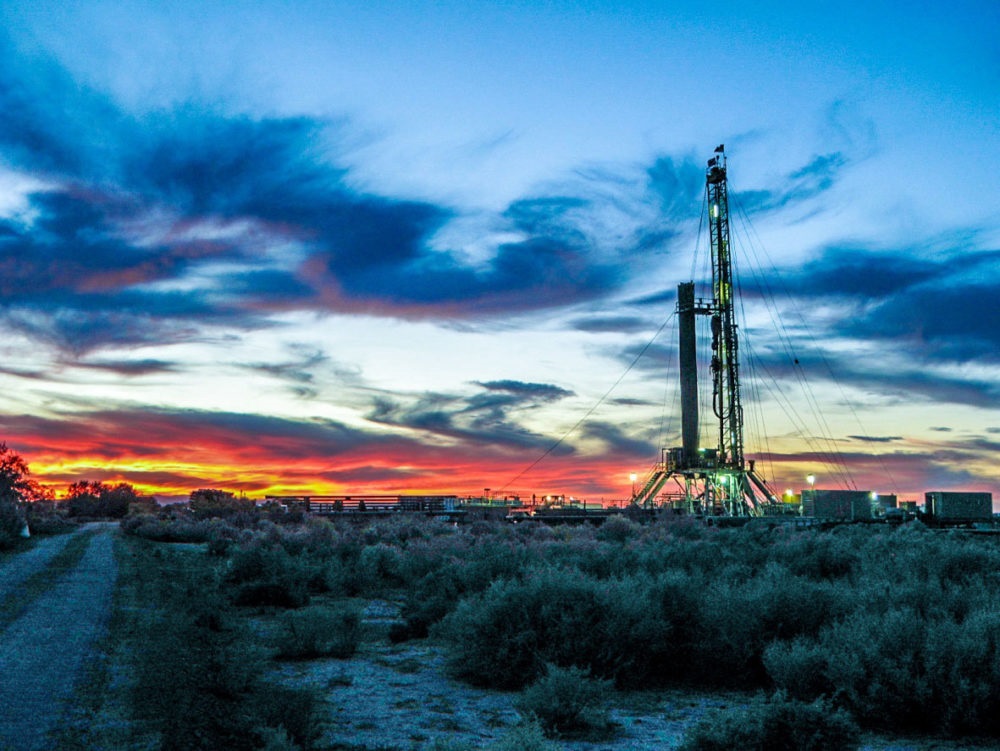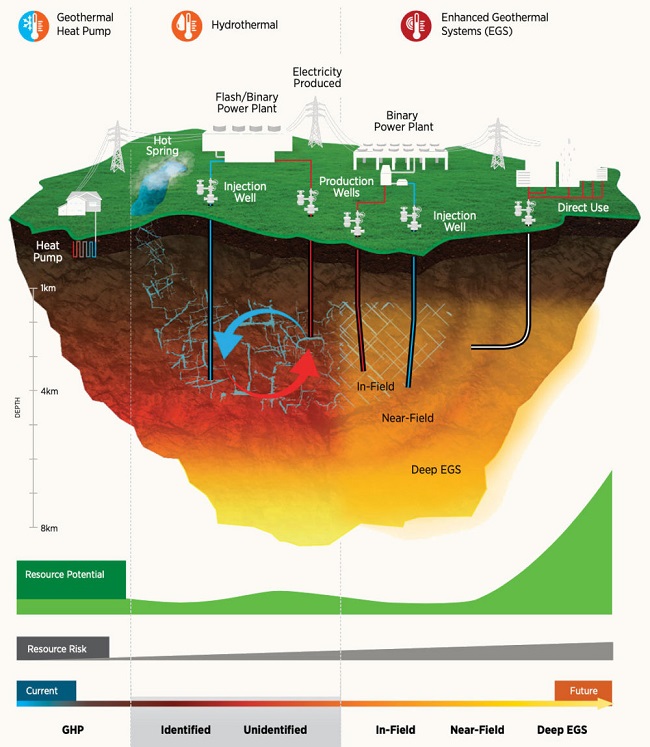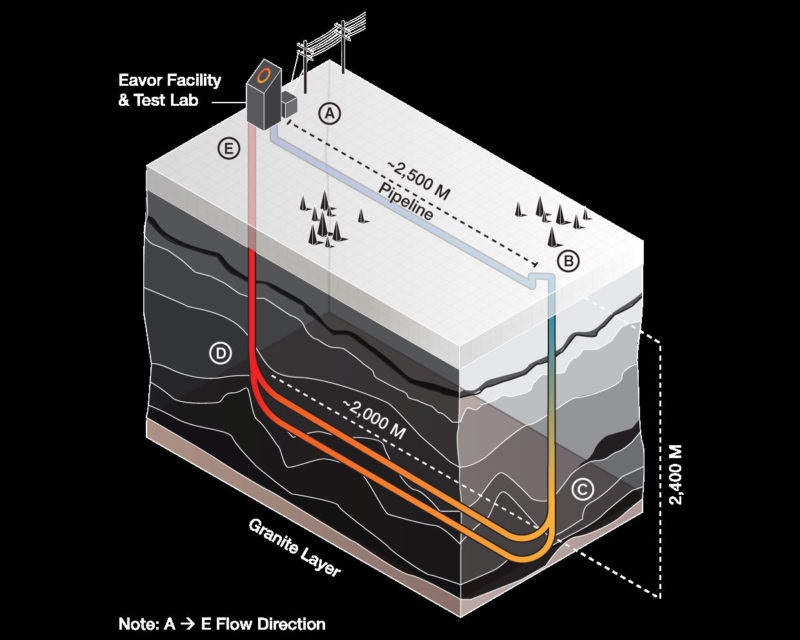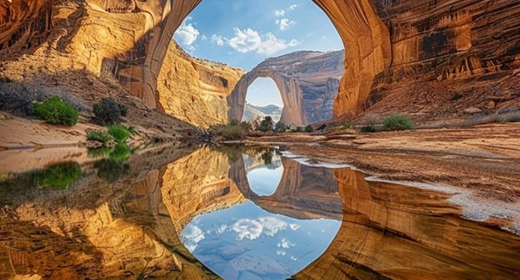by Jim Robbins: Aided by advances in deep-drilling technology for fracking, engineers are developing new methods of tapping into the earth’s limitless underground supplies of heat and steam…
But the costs of accessing deep geothermal energy are high, and initial government support will be crucial.
river of hot water flows some 3,000 feet beneath Boise, Idaho. And since 1983 the city has been using that water to directly heat homes, businesses, and institutions, including the four floors of city hall — all told, about a third of the downtown. It’s the largest geothermal heating system in the country.
Boise didn’t need to drill to access the resource. The 177-degree Fahrenheit water rises to the surface in a geological fault in the foothills outside of town.
It’s a renewable energy dream. Heating the 6 million square feet in the geothermally warmed buildings costs about $1,000 a month for the electricity to pump it. (The total annual cost for depreciation, maintenance, personnel, and repair of the city’s district heating system is about $750,000.)
“We’re heating 92 of the biggest buildings in the city of Boise,” said Jon Gunnarson, the city’s geothermal coordinator. “The buildings strip heat, collect it, and run it to an injection well. We use it once and reinject it and use it again.”
The Boise district system is how geothermal energy is most often thought of — natural hot water is pumped into radiators or used to generate electricity. It is considered a local phenomenon — few places are sitting on an underground river of steaming hot water — and so geothermal has not been viewed as a major feature on the alternative energy landscape.
Many experts see geothermal power as an essential component of the world’s green-energy future.
But a number of experts around the world say that notion is wrong. Thanks especially to the deep-drilling techniques and knowledge about underground formations developed by the oil and gas industry during the fracking boom, a type of geothermal energy called deep geothermal can access hot temperatures in the earth’s mantle as far down as two to three miles. At various depths up to this level, much of the planet contains extremely hot water or there is hot rock into which water can be injected and heated, a technology known as enhanced geothermal systems. In either case, the hot water is pumped out and used to directly heat buildings or to generate electricity with steam or hot water.
“Wherever we are on the surface of the planet, and certainly the continental U.S., if we drill deep enough we can get to high enough temperatures that would work like the Boise system,” said Jefferson Tester, a professor of sustainable energy systems at Cornell University and a leading expert on geothermal energy. “It’s not a question of whether it’s there — it is and it’s significant. It’s a question of getting it out of the ground economically.”
Even though geothermal is barely on the alternative energy radar, the U.S. already produces 3.7 gigawatts (GW) of geothermal electricity, enough to power more than 1 million homes. It’s the world’s leading producer — primarily in central California and western Nevada. California has 43 operating geothermal generating plants, and is about to build two more.
With mandated renewable energy targets in many locales and the Net Zero campaign — a commitment by many countries to decarbonize their economies by 2050 — interest in geothermal energy is growing rapidly. Many experts see it as an essential component of the world’s green-energy future because it could provide carbon-free heat and around-the-clock baseload power to compensate for the intermittency of wind and solar. Iceland, which sits on an active geological fault line, perfected the technology with its ubiquitous geothermal district heating systems. And China is embracing the move to geothermal power, currently developing more geothermal district heating systems than any other nation.
“Geothermal electricity is always on ,” said Tester. “It can provide fully dispatchable power or heat and is scalable in the same way other renewables are.”
In a recent report, the International Renewable Energy Agency (IRENA) predicted the output of geothermal in Europe could increase eight-fold by 2050. And a 2019 U.S. Department of Energy (DOE) report — GeoVision: Harnessing the Heat Beneath Our Feet — refers to the “enormous untapped potential for geothermal.” By overcoming technical and financial barriers, the report says, generating electricity through geothermal methods could increase 26-fold by 2050, providing 8.5 percent of the United States’ electricity, as well as direct heat.
“GeoVision models indicate the opportunity for more than 17,500 direct-heating installations as well as heating and cooling for the equivalent of more than 28 million households using geothermal heat pumps by 2050,” wrote Susan Hamm, director of DOE’s Geothermal Technologies office.
Accessing deep geothermal is expensive and risky. But with a global focus on decarbonizing economies, many countries could offer risk-mitigation strategies and financial incentives, including tax benefits, cost sharing, and technical research. The U.S. Department of Energy, for example, has committed $150 million to the Frontier Observatory for Research in Geothermal Energy (FORGE) project in Utah as a study and test site for enhanced geothermal.
A type of deep geothermal “would be as pretty damn close to the holy grail as you can get,” says an advocate.
Experts expect geothermal will receive a boost from the incoming Biden administration, which — in stark contrast to the Trump administration — has made a major commitment to slashing the U.S.’s greenhouse gas emissions
Several types of geothermal are increasingly being deployed these days. One, which has been around for decades, has nothing to do with hot water. It’s called “ground source heat pump technology” (GSHP), and it capitalizes on the difference in air temperature and ground temperature. In winter in cold climes, the ground, at 55 degrees F or so, is warmer than outdoor temperatures — and pipes with antifreeze circulate through the ground and pump that warm fluid into a home. Supplemental heat can bring up the temperature. In summer, the ground stays cooler and this same system can provide air conditioning. Sweden is a world leader in this approach and a fifth of the homes there use GSHP. A major hurdle for many homeowners, however, is the cost, which can run into the tens of thousands of dollars per dwelling.
Another very different kind of geothermal is a deep closed loop. A system called the Eavor Loop is operating in Alberta, Canada. It features a single hole drilled down about 1.5 miles, then laterally for a similar length through extremely hot geological formations, and then back up to the surface. The entire hole is lined with pipe and then filled with fluid. It’s a kind of natural radiator. As the heat-transfer solution travels through the length of pipe, it’s heated by the high ground temperatures and then flows to the surface.
Because of the nature of thermodynamics — hot water is lighter than cold and rises — this system doesn’t need a pump and continually runs on its own, a kind of perpetual-motion energy producer. A test facility is operating in Alberta, according to Eavor, but data has not been made publicly available. Another similar well is being drilled by Eavor in Bavaria, Germany.
Michael Liebreich, chairman of the Eavor board and a leading industry analyst with BloombergNEF — a clean energy research firm — told the online news site Recharge that “it would be as pretty damn close to the holy grail as you can get… if it can be done at an affordable price.”
Tester is intrigued by the claims made for the Eavor deep closed loop concept, but said it’s difficult to assess how well the technology works because data on its performance has not been made public. “I think it will work,” he said. “It’s a question of how well.”
Tester is a strong believer in a technology called open-loop deep geothermal, also known as heat mining. In an open loop system, the fluid is pumped under high pressure down a lined drill hole to break up hot rock to increase its surface area — essentially a type of fracking. Then water is injected in one well, naturally heated by the geology, and pumped out a production well. The two wells are in the same geological vicinity, but are not connected.
The Eavor Loop geothermal system does not need a pump to operate, with hot water naturally rising to the surface and cold water naturally sinking. COURTESY OF EAVOR
Tester is helping plan and implement such a system for Cornell, with drilling expected to commence this spring. Three or four well pairs will be drilled as deep as three miles, and each well will cost $6 million or $7 million. With plumbing, controls, and monitoring for seismicity, the entire system could eventually cost some $100 million, paid for by government and private sources, says Tester.
That is a high price tag, but Tester says that if the geology proves to be workable the system will provide all the heat for the 30,000-person campus for many decades to come. The ongoing costs of maintaining the system will be negligible, Tester says, and if a federal price on carbon is ever adopted, the investment in expensive geothermal would become more attractive.
While deep geothermal is in the early stages in the U.S., other countries have made great strides and it is a proven technology. Iceland, a volcanic island, has a plethora of hot water resources and has implemented deep geothermal along with plentiful near-surface sources. More than 90 percent of the country’s citizens have homes heated by direct heat from geothermal.
With technical expertise from Icelandic engineers, the Chinese have implemented numerous geothermal systems, in part to eliminate the choking pollution from burning coal. “In a decade, the Chinese have become the world’s largest deployer of geothermal district heating,” said Tester. It is an important component in the nation’s transition away from fossil fuels.
To grow as a solution, geothermal must overcome significant financial and technical barriers.
Beneath Paris, the Dogger Aquifer, first tapped for district heating in 1969, now supplies hot water heat for 250,000 homes, and is expanding. The project drills down to 1.2 miles to tap hot water, pumps it to the surface, distributes it around Paris, and re-injects it into the aquifer.
Germany, too, is going big on geothermal. Munich, for example, has a goal of switching the city entirely to district heating. One large deep geothermal plant is scheduled to go online in 2021 to provide hot water district heat to 80,000 households, adding to other plants across Germany that are tapping into geothermal resources. Experts believe Germany can go from 1.2 terawatt-hours (TWh) of heat from geothermal today to 100 TWh by 2050.
With their deep-drilling expertise and knowledge about what lies at the bottom of deep holes, oil and gas companies are exploring deep geothermal. Engineers in the small town of Hinton, Alberta are studying the feasibility of converting some of its existing 4,000 oil and gas drill holes into geothermal wells. The temperature at the bottom of some of the holes reaches 140 degrees Celsius — 284 degrees F.
Why, if geothermal is so promising, has deep district geothermal lagged behind other clean energy sources? The main reason is high upfront costs. “To grow as a national solution, geothermal must overcome significant technical and non-technical barriers in order to reduce cost and risk,” wrote the DOE’s Hamm in her introduction to the GeoVision report. “The subsurface exploration required for geothermal energy is foremost among these barriers, given the expense, complexity, and risk of such activities.”
Experts say that governments have to help finance geothermal projects and get involved on the front end to mitigate risk. “Additional incentives have to be set in place,” said Francisco La Camera, director general of the International Renewable Energy Agency, told Thinkgeoenergy.com, an industry website. “It’s crucial that all the risk and the cost of the first phase are taken into account by policy makers to make geothermal more attractive.”
In the U.S., Tester envisions a gradual switch to district heating by first transforming military bases, hospitals, schools, universities, and state and federal government complexes with public and private funding.
One potential problem, though rare, is that deep drilling and fracking are known to induce seismicity and cause earthquakes. The famous example is an enhanced geothermal system drilled in Pohang, South Korea in 2017. Injecting fluid at high pressure to fracture the hot geology to release heat caused a 5.4-magnitude earthquake — the strongest in the area’s recent history — that injured 135 people and caused nearly $300 million in damage.
“There certainly is seismicity with anything you do underground,” said Tester. “Controlling that and monitoring that is usually what is done in any subsurface injection. I don’t see it as the biggest challenge facing geothermal… The biggest challenge is productivity. Insuring that these connected systems between injection wells and production wells produce enough fluid to justify the economic investment to drill to that sort of depth.”
Geothermal is destined to play a large role in the world’s clean energy future, many experts believe, but it will need to be coupled with other technologies. “Wind, solar, geothermal, and nuclear as well,” said Tester. “It’s an all-of-the-above strategy.”
Source: E360













































